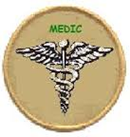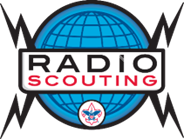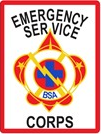About the Emergency Service Corps
We are a committee within the Greater Colorado Council.
History
ESC 2012 - In 2012 a fire south of the McNeil Scout Ranch required the camp to be evacuated. Camp Staff successfully evacuated all personnel the Kiowa Campgrounds. However once safely settled it was found there was a lack of immediate resources to support the evacuees. Lessons learned from this event led the Greater Colorado Council to create the Emergency Preparedness Committee which has since reformed the Emergency Service Corps.
Vision
Have personnel, processes and tools available to support the Scouting Program and the Community in times of need.
Goals
Motto
Be Prepared - To Help Other People at all Times
About Us
ESC 1939 - 1948 In 1939, a series of Emergency Service programs to specifically train and prepare older Boy Scouts to provide community support during emergencies were put in place. The program had older Scouts prepared to assist in various emergency situations by having them certified in various skills to earn the right to participate. It had two parts to it, the Corps member, a trained Senior Scout and an apprentice member, who had not yet completed all the training. Insignia was created, both for uniform wear and as armbands, and requirements were set to earn the right to wear such insignia. If a unit had a certain number of members certified in Emergency Service, then the unit was considered an Emergency Service Unit. The program grew out of the need for preparedness on the home front for World War II and from earlier BSA programs. In the postwar years, the program continued with the heightened need for Civil Defense and emergency preparedness. As part of this program, every Boy Scout and Explorer unit was to have a mobilization plan. Starting in the 1960s, the need for these sorts of programs declined, in part due to the beginning of Emergency Medical Response systems in most communities, and the program was discontinued in the early 90s.
Calendar
ESC event calendar
All Events List

Training
Members of the GCC Emergency Service should take FEMA training based on their positions within the organization.
FEMA Independent Study Exams now require a FEMA Student Identification (SID) Number. If you do not yet have a SID, you may register for one at: https://cdp.dhs.gov/femasid. Please do not contact the Independent Study program office as they are unable to provide assistance with these requests.
If you have an inquiry regarding the FEMA Independent Study Program, NIMS or other Emergency Management Institute (EMI) related requests such as: requests for certificates, transcripts, online test scores/results, please contact the FEMA Independent Study program office at 301-447-1200 or email Independent.Study@fema.dhs.gov for further assistance. Please do not contact the FEMA SID Help Desk as they are unable to provide assistance with these requests.
-
Distance Learning
The Emergency Management Institute (EMI) offers self-paced courses designed for people who have emergency management responsibilities and the general public. All are offered free-of-charge to those who qualify for enrollment. To get a complete listing of courses, click on Course List link below. https://training.fema.gov/is/
-
The following courses are required for all GCC Emergency Service Staff:
IS-100.b: Introduction to Incident Command System, I-100
As an introduction to the Incident Command System (ICS), this course provides the foundation for higher level ICS training. This course describes the history, features and principles, and organizational structure of the Incident Command System. It also explains the relationship between ICS and the National Incident Management System (NIMS). (0.3 CEUs)
IS-200.b: ICS for Single Resource and Initial Action Incidents
This course is designed to enable personnel to operate efficiently during an incident or event within the Incident Command System (ICS). ICS 200 provides training on and resources for personnel who are likely to assume a supervisory position within the ICS. (0.3 CEUs)
IS-700.a: National Incident Management System (NIMS), and Introduction
This course introduces and overviews the National Incident Management System (NIMS). NIMS provide a consistent nationwide template to enable all government, private-sector, and nongovernment organization to work together during domestic incidents. (0.3 CEUs)
IS-800.b: National Response Framework, an Introduction
Introduces participants to the concepts and principles for the National Response Framework. This course is intended for government executives, private-sector and non-governmental organizations (NGO) leaders and emergency management practitioners. (0.3 CEUs)
-
Optional Training:
It is highly recommended that one or several members of the GCC Emergency Staff take this training:
IS-29.a: Public Information Officer Awareness
The Public Information Officer Awareness Course (IS0029) is designed to familiarize participants with the concepts underlying the PIO role. This course can provide a basic understanding of the PIO function for those new to the position. Additionally, it can provide those in executive level roles the necessary knowledge of PIO roles and responsibilities during an emergency. (0.7 CEUs)
IS-36: Multihazard Planning for Childcare
This course is designed for childcare providers of all sizes and for all age children, including, but not limited to, home childcare sites, childcare facilities, nursery schools, camps, scouts, sports programs, faith-based programs, and after-school programs. However, anyone with a personal or professional interest in childcare site preparedness is welcome to participate. Teachers, camp counselors, parents, volunteers, scout leaders, and coaches alike will find useful information in this course. (0.2 CEUs)
IS-235.c: Emergency Planning
This course is designed for emergency management personnel who are involved in developing an effective emergency planning system. This course offers training in the fundamentals of the emergency planning process, including the rationale behind planning. It will develop your capability for effective participation in the all-hazard emergency operations planning process to save lives and protect property threatened by disaster. (0.5 CEUs)
IS-242.c: Effective Communication
This course is designed to improve your communication skills. It addresses: Basic communication skills; How to communicate in an emergency: How to identify community-specific communication issues; Using technology as a communication tool; Effective oral communication; How to prepare an oral presentation. (0.8 CEUs)
IS-244.b: Developing and Managing Volunteers
The goal of this course is to strengthen abilities to prepare for and manage volunteers before, during, and after a severe emergency or major disaster. This course will: Provide strategies for identifying, recruiting, assigning, training, supervising, and motivating volunteers. Include discussion of spontaneous volunteers as well as those affiliated with community-based, faith-based, and nongovernmental organizations (NGOs). (0.4 CEUs)
IS-271.a: Anticipating Hazardous Weather and Community Risk, 2nd Edition
This course provides emergency managers and other decision makers with background information about weather, natural hazards, and preparedness. This module offers web-based content designed to address topics covered in the multi-day Hazardous Weather and Flood Preparedness course offered by the Federal Emergency Management Agency (FEMA) and the National Weather Service (NWS). (0.9 CEUs)
IS-288.a: The Role of Voluntary Organizations in Emergency Management
This course provides a basic understanding of the history, roles, and services of disaster relief volunteer agencies in providing disaster assistance. It is appropriate for both the general public and those involved in emergency management operations. (0.1 CEUs)
IS-319: Tornado Mitigation Basics for Mitigation Staff
The goal of this course is to help members of FEMA’s Hazard Mitigation disaster workforce successfully communicate to the public the risks associated with tornados, and the mitigation measures available to improve personal safety and reduce damages to structures and personal property. This module is one in a series of Independent Study modules for the Hazard Mitigation disaster workforce, which addresses appropriate basic mitigation information for public consumption regarding earthquakes, floods, hurricanes, tornados, and wildfires. (0.1 CEUs)
IS-320: Wildfire Mitigation Basics for Mitigation Staff
The goal of this course is to help members of FEMA’s Hazard Mitigation disaster workforce successfully communicate to the public the risks associated with wildfires, and the mitigation measures available to improve personal safety and reduce damages to structures and personal property. This module is one in a series of Independent Study modules for the Hazard Mitigation disaster workforce, which addresses appropriate basic mitigation information for public consumption regarding earthquakes, floods, hurricanes, tornados, and wildfires. (0.1 CEUs)
IS-328: Plan Review for Local Mitigation Plans
This course provides State and FEMA staff that review Local Mitigation Plans with the information and training they will need to determine if a plan meets federal mitigation planning requirements. (0.4 CEUs)
IS-366.a: Planning for the Needs of Children in Disasters
Provides guidance for Emergency Managers and implementers of children’s programs about meeting the unique needs that arise among children as a result of a disaster or emergency. (0.6 CEU’s)
IS-907: Active Shooter: What You Can Do
This course provides guidance to individuals, including managers and employees, so that they can prepare to respond to an active shooter situation. (0.1 CEUs)
IS-909: Community Preparedness: Implementing Simple Activities for Everyone
The purpose of this course is to present a model program for community preparedness. In addition, resources are available to help organizations conduct simple preparedness activities for everyone. (0.1 CEUs)
IS-951: DHS Radio Interoperability
The intent of the DHS Radio Interoperability Course is to provide a mechanism for DHS employees in all related disciplines who utilize radio communications systems to understand the operation of portable/mobile radios, the basics of how radio systems work, and the principles and concepts of interoperable communications (especially within the National Incident Management System). Additionally, this training will provide instruction on how to locate and properly use the DHS Common Interoperability Channels. (0.2 CEUs)
Services
ESC

ESC Services
What about it?.
-
BSA Incident Reporting
The BSA Incident Reporting tool and requirements have been updated. All Scouters are responsible for properly reporting any Incidents, Accidents or “Near Misses” during Scout events and activities. The new website, form and instructions can be found on the BSA Incident Landing Page. incident-report
Medic Call List
Bryan Faulkner

Medic Program
Each Scouting Event or Activity needs to have a designated Medic. The training and qualification requirements for Medics to support a Scouting activity will vary depending on several factors including location and number of people involved. A Medic for many Greater Colorado Council events can be only 1st Aid/CPR/AED certified while for other activities Medics with Wilderness First Aid, First Responder or more advanced certifications are required.
-
Medic Call List
To assist the Council and District find Medics to support events and activities the ESC committee maintains a Medic Call List. Volunteers who are willing to support Scouting events and activities as a Medic provide their names and other information to the ESC Team. When a request to help find Medics to support an upcoming Scouting event or activity is received, we send that request with details out to the Medic Call List and see if there is anyone available to support part or all the events. The names of the Medic Call List and their contact information is not shared with event organizers, to prevent the people on the list being inundated with individual requests.
The level of medical support training and qualifications for any given event is based on the size of the event and distance / response time of on-call medical services. In example, for a scouting event in the Denver Metro area or Peaceful Valley Scout Ranch, on-call EMTs are available on average within 10 minutes or less, so on-site medical support for a small activity can be someone with only Basic 1st Aid, AED/CPR training. Events that are farther away or have a larger number of participants require more Medics and higher levels of certification.
When a request to help identify volunteer medics for an event is received the location and level of qualifications required to support the event are evaluated. We then send the request out to the call list and ask people who meet or exceed the needed level of training if they are available to support the event and for how long.
-
Are you a Medic?
Would you like to volunteer to be on the Medic Call List? If you would like to volunteer to be on the call list simply let us know by using the website contact. Please provide your name, email and phone number as well as the following information:
Medical Training level - 1st Aid/CPR/AED to Physician
Any Medically Related Specialty – Whitewater, Rock Climbing, etc.
Associated Scouting District / Unit if you want to focus on those
Preferences - Anything specific, like only available on weekends, etc...
Radio Scouting
George Weber

Radio Scouting
Amateur radio provides an exciting and engaging introduction to a wide range of technologies with a STEM foundation.
We provide the fun of communicating with other Scouts, and the magic of long distance communication, even in remote
areas without cell service. We can help Scouts and leaders with amateur radio education, Scout advancement, and integrate
amateur radio into scouting activities.
Ham radio has been a part of Scouting since 1918 with the inauguration of the Wireless merit badge. This merit
badge, among many, is part of Scouting’s legacy of providing concise information and rigorous requirements to introduce
Scouts to hobbies, vocations and generally fun stuff. The list of merit badges today numbers over 130, covering diverse
topics from Nuclear Science to a recently introduced Welding merit badge. This article provides a brief overview of Radio
Scouting, yesterday and today. The images described in this article are visible at lower left.
-
Radio Merit Badge
Not surprisingly, the history of the Radio merit badge reflects the history of Amateur Radio. For example, the 1922 merit badge pamphlet shows a requirement of receiving Morse code at a rate of 10 WPM, in 1930 the requirement was 5 WPM and in 1984 the code requirement was dropped completely. Since then, the number of Radio merit badges earned each year has grown from roughly 1000 per year to more than 7000 in 2009.
-
Morse Code Interpreter Strip
Even though Scouting dropped the Morse code requirement from the Radio merit badge, it has recently introduced a Morse code interpreter strip. An interpreter strip, worn on the youth or adult Scout uniform over the right pocket, designates those who are proficient in a language and denotes their availability to translate that language for others. In this case, the patch indicates that a Scout or Scout leader is available for disaster communication or other types of supporting communication for Scouting and the community. The patch is in code, with the word M-O-R-S-E spelled out. The requirements for the interpreter badge are to show knowledge of Morse code by carrying on a 5 minute conversation at 5 WPM, copying correctly a 2 minute message sent at 5 WPM and sending a 25 word message at 5 WPM. These requirements are very similar to those for other languages such as French, Spanish, American Sign Language, etc.
-
Jamboree-on-the-air
Jamboree-on-the-Air is an annual event that fosters Scout-to-Scout communication across borders — be it city, county, state, country or even between continents. It is not a contest but a way to get everyone on the air at the same time to communicate with their fellow Scouts, learn about their Scouting experiences, wherever they live, and introduce them to the fun and technology of Amateur Radio. Its purpose is to foster conversations rather than multiple contacts.
JOTA is the largest Scouting event in the world. In 2011 nearly 750,000 Scouts participated with over 6000 stations in operation from 150 countries. The 55th JOTA will be held October 20–21, 2012. Participation in the US has been at a high, but generally unmeasured level. In 2011, with the first US reporting system in place, 68 stations reported over 3000 Scouts in attendance and this with many active stations not reporting. Hopefully, that can be increased in 2012.
This event is organized by the World Organization of the Scout Movement and in each country by the country’s national JOTA organizer and national Radio Scouting committee.
Resources
ESC committee has numerous resource available to units in the Greater Colorado Council
Many documnets from the ESC are available via Dropbox Click here

ESC Resources
What about it?.
-
Walkie-Talkies
The ESC committee has Walkie-takies avaialble for units to loan. These are provided to unit at no cost and loans\ can be arrigned with TODO: WHo??
References
ESC committee has numerous referefences available to units in the Greater Colorado Council

ESC References
What about it?.
-
BSA Incident Reporting
The BSA Incident Reporting tool and requirements have been updated. All Scouters are responsible for properly reporting any Incidents, Accidents or “Near Misses” during Scout events and activities. The new website, form and instructions can be found on the BSA Incident Landing Page. incident-report
Monthly Reports
ESC committee hold monthly committee meetings.
Contact
The Emergency Service Corp is a committee of the Greater Colorado Council
Location
10455 W 6th Ave #100, Lakewood, CO 80215
Brad Johnston - Emergency Service Corps, Chair
303.396.2322 / KE0DCP
Email Us
brad.johnston@gccesc.org
